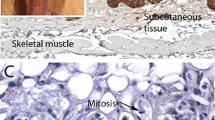Abstract.
Purpose: To develop a highly reproducible model of disseminated childhood neuroblastoma in mice to allow secondary evaluation of therapeutics against microscopic disseminated disease. Methods: CB17/Icr SCID were injected i.v. with 103 to 5×106 human NB-1691 neuroblastoma cells. NB-1691 cells were detected by PCR for synaptophysin and tyrosine hydroxylase in peripheral blood, and bone marrow. Therapeutic studies evaluated topotecan and vincristine as single agents or in combination. Topotecan was administered i.v. daily for 5 days on two consecutive weeks. Courses were repeated every 21 days for three cycles. Vincristine (1 mg/kg) was administered i.v. every 7 days for nine consecutive weeks. Treatment started 11–21 days after tumor cell inoculation. Results: Following injection of ≥1×105 cells 100% of mice developed disease. Mice inoculated with 107 cells survived a median of 42 days. Survival time was a linear function of the cell inoculum. At autopsy, gross tumor was routinely detected in many organs in particular liver, ovaries, kidneys and adrenals. NB-1691 cells were detected by PCR in peripheral blood, and bone marrow. Immunohistochemical staining showed that lesions were strongly positive for synaptophysin, chromogranin A and negative for leukocyte common antigen. Topotecan (0.6 mg/kg) alone extended median survival from 44 days (controls) to 95 days. When treatment was started 21 days after inoculation of NB-1691 cells, topotecan extended median survival from 39 days (controls) to 91 and 99 days at dose levels of 0.3 and 0.6 mg/kg, respectively. Vincristine (1 mg/kg) extended survival by a median of 9.5 days. In combination with vincristine (1 mg/kg), median survival was increased to 141 days (topotecan 0.6 mg/kg) and 159 days (topotecan 1.0 mg/kg). Conclusion: This model of disseminated neuroblastoma is highly reproducible. As this model may more closely simulate childhood disease it may be a valuable adjunct in develo** new approaches to advanced stage, poor prognosis neuroblastoma.
Similar content being viewed by others
Author information
Authors and Affiliations
Additional information
Electronic Publication
Rights and permissions
About this article
Cite this article
Thompson, J., Guichard, S., Cheshire, P. et al. Development, characterization and therapy of a disseminated model of childhood neuroblastoma in SCID mice. Cancer Chemother Pharmacol 47, 211–221 (2001). https://doi.org/10.1007/s002800000235
Received:
Accepted:
Issue Date:
DOI: https://doi.org/10.1007/s002800000235




